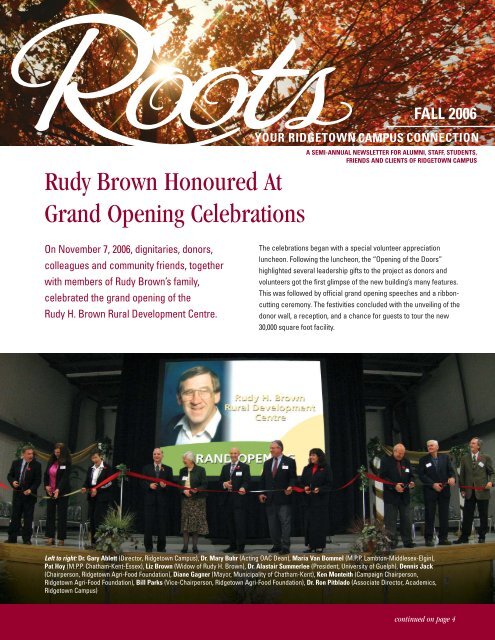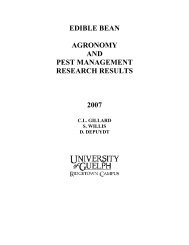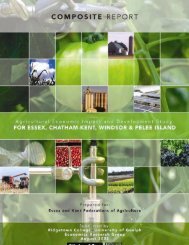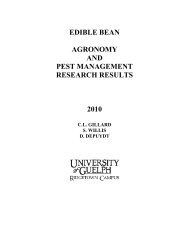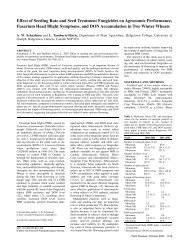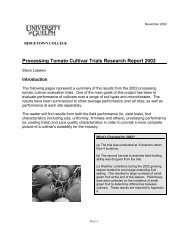Rudy Brown Honoured At Grand Opening Celebrations - Ridgetown ...
Rudy Brown Honoured At Grand Opening Celebrations - Ridgetown ...
Rudy Brown Honoured At Grand Opening Celebrations - Ridgetown ...
You also want an ePaper? Increase the reach of your titles
YUMPU automatically turns print PDFs into web optimized ePapers that Google loves.
A Message From...OAC DeanCongratulations on the grand opening of the<strong>Rudy</strong> H. <strong>Brown</strong> Rural Development Centre.This new facility reflects the commitmentand dedication of staff, volunteers, andmany generous donors.It marks the beginning of a new era for<strong>Ridgetown</strong> Campus, with new facilities,enhanced educational programs andleading edge research for agriculture,food and the environment.The first cohort of degree students began their studies atthe campus this September, enrolled in the EnvironmentalManagement major of the unique Bachelor of Bio-ResourceManagement program. Over the next four years, through studiesat two University of Guelph campuses, these pioneers willdevelop the science, technology and business skills requiredto launch successful careers in environmental management.<strong>Ridgetown</strong>’s growing profile as an environmental leader is furtherenhanced by new research focused on areas such as nutrientmanagement and the development of biological sources of energy.In September 2007, the BBRM program will expand further whenthe Equine Management major begins at Kemptville Campus.This continued development of OAC’s regional campuses asproviders of distinctive, high quality educational programs hasbeen designed to fulfill industry requirements for skilled workers,while meeting the needs of a new generation of learners.My thanks to you all for your continued commitment to excellencein food, life, and leadership.Dr. Craig J. PearsonDean, OACROOTS StaffJanet Nauta, EditorLiz Meidlinger, Project ManagerPhoto SupportJoseph KrogmanRichard ArmstrongDeuce Design Inc.Blenheim News TribuneAddress Updates, Alumni Corner Newsor ROOTS story ideas:Janet NautaAlumni Services Co-ordinatorE-mail: roots@ridgetownc.uoguelph.caPhone: 519-674-1504University of Guelph, <strong>Ridgetown</strong> Campus120 Main Street East,<strong>Ridgetown</strong>, ON NOP 2C0Phone: 519-674-1500Fax: 519-674-1530www.ridgetownc.uoguelph.ca<strong>Ridgetown</strong> Campus DirectorThe <strong>Rudy</strong> H. <strong>Brown</strong> Rural Development Centreis now open and it is simply fantastic. It was aremarkable team effort, and our thanks andappreciation go out to each of you who workedso hard on the fund raising and construction forthis very important project. Well done indeed.This will be my final message for ROOTS, as mytenure as Director is coming to a close in earlyJanuary, 2007. For me, it has truly been an honourand privilege to serve as Director of this wonderfulinstitution. <strong>Ridgetown</strong> is blessed with very talented and dedicated facultyand staff, all of whom work hard for the diversified clients that we serve.I am indebted for their support and guidance over the last 10 years.In this position, I have had the opportunity to meet and work with a greatnumber of exceptional folks and have enjoyed tremendous workingrelationships with them all. Whether alumni, OMAFRA staff, Universitycolleagues, municipal government, industry or community - all have beenextremely helpful and willing to discuss how we might strengthen,improve and broaden the educational, research, extension and businessdevelopment programs that <strong>Ridgetown</strong> offers.The <strong>Ridgetown</strong> Agri-Food Foundation, which was formed by alumni andindustry supporters in 1997, has been a personal delight to work with.The dedication of this group to <strong>Ridgetown</strong> is truly remarkable. Despitehaving very busy careers and responsibilities, they have made theCampus a priority and contributed significantly to the success thisinstitution enjoys.Although we became part of the University of Guelph in 1997, the Ministryof Agriculture, Food and Rural Affairs still continues to provide verysignificant funding, direction and support to this campus. Clearly, wewere only able to construct the Rural Development Centre as a resultof fantastic Ministry and provincial government financial support.We continue to enjoy and value highly our very good working relationshipwith OMAFRA and its employeesSimilarly, the leadership at the University of Guelph, headed by PresidentAlastair Summerlee, VP-Research Alan Wildeman, Dean Craig Pearsonand AVP Rob McLaughlin, has been vital to the <strong>Ridgetown</strong> Campus.Their willingness to share their skill, wisdom and vision has been greatlyappreciated. They are all great supporters of the <strong>Ridgetown</strong> campus andwhat we believe in.Being Director of the <strong>Ridgetown</strong> Campus, University of Guelph, has beena remarkable experience. I thank you all for this opportunity and for yoursupport. It has been a blast.Dr. Gary AblettDirector, <strong>Ridgetown</strong> Campus2roots@ridgetownc.uoguelph.ca
<strong>Ridgetown</strong> College Is NowUniversity of Guelph,<strong>Ridgetown</strong> CampusThis school has gone through several name changes inits 55-year history. From its roots as the Western OntarioAgricultural School to <strong>Ridgetown</strong> College of AgriculturalTechnology to <strong>Ridgetown</strong> College, over 5,000 studentshave graduated since the first students started in 1951.In the spring of 2006, a new name was announced –University of Guelph, <strong>Ridgetown</strong> Campus.“The new name clearly reflectsthe integration of the <strong>Ridgetown</strong>teaching and research programswithin the University of Guelph,”says Dr. Gary Ablett, CampusDirector. <strong>Ridgetown</strong> Campushas been part of the University of Guelph since 1997. “This name change is apositive opportunity to let all our potential students, clients and stakeholdersknow that we are a unique campus within the University of Guelph. <strong>Ridgetown</strong>College has been a well respected name in the rural community, and nowadding the University of Guelph to the name, with its world-wide reputation,clearly enhances our campus recognition,” notes Associate Director,Dr. Ron Pitblado.<strong>Ridgetown</strong> Campus has significantly benefited from its integral relationshipwith the University of Guelph. The University affiliation has allowed increasedresearch funding opportunities, and encouraged new education andextension programs. University of Guelph, <strong>Ridgetown</strong> Campus also supportsgraduate students completing their Masters of Science and Doctor ofPhilosophy degrees.Degree Students BeginClasses at <strong>Ridgetown</strong>University of Guelph’s <strong>Ridgetown</strong> Campushas welcomed the first undergraduate degreestudents in the institution’s history. Students inthe new Bachelor of Bio-Resource Management(BBRM) program, studying in the EnvironmentalManagement major, will complete their first twoyears of the four year program at <strong>Ridgetown</strong>.They will complete their final two years of studyat the University’s Guelph campus. The newdegree program offers students a unique blendof applied and theoretical environmental training,with an emphasis on business skills andexperiential learning opportunities.“Graduates from this program will be wellpreparedfor a wide variety of environmentalcareers,” says Dr. Gary Ablett, Campus Director.“These students represent a milestone in ourinstitution’s history and offer a glimpse of theinnovative educational opportunities that canand will be delivered at this campus. This excitingnew undergraduate program is the result of strongUniversity leadership and complements OAC’sprogram priorities in the areas of environment,agriculture, food and rural communities.The new group of undergraduate studentscomes from across the province. Michelle Verbeek,a <strong>Ridgetown</strong> resident, is one of the students in thefirst BBRM class. “I chose this program becausethere are many diversified job opportunities inenvironmental management,” she says. “Havinguniversity courses offered locally is also a greatadvantage.” London resident Chris Williamson isenjoying his experience in <strong>Ridgetown</strong>. “The smallcampus is awesome and it’s easy to meet newpeople,” he says. Michael Armstrong, a Guelphresident notes, “Today we were in campus testplots using soil probes. It was great to be learningsoil science in the field.”In total, almost 500 degree, diploma and certificatestudents are studying at <strong>Ridgetown</strong> this year,with enrollment remaining very strong in theAgriculture diploma, a cornerstone programfor the campus.3
▲ With seating for 1200 people, the new Pestell Auditorium will be put to manygood uses by agricultural and community groups. The new auditorium wasthe perfect location for the grand opening speeches and reception.▲The Donor Recognition Wall, unveiled by Liz <strong>Brown</strong>and former staff member and <strong>Ridgetown</strong> alumnus, KenStevenson acknowledges the many donors, volunteers,and alumni who supported this project. It also honoursseveral individuals who were remembered throughmemorial gifts to the building project. Stevenson,retired and living almost next door to the campus,played an integral role in supporting the developmentof Alumni gifts to the campaign.Donors recognized on the wall contributed gifts from$1,000 to more than $250,000.A beautiful skylight sets off the Monsanto Foyer.▲5
<strong>Grand</strong> <strong>Opening</strong> <strong>Celebrations</strong>continued from previous pageLeadership Donors OpenDoors of LearningMore than 1,000 donors supported thenew Centre. Several organizations andindividuals provided leadership gifts,offering them the opportunity to havea room or a specific area in thebuilding named in their honour.“Government support hasbeen key to this initiative.It underscores the importanceof our enhanced partnershipagreement with the OntarioMinistry of Agriculture,Food and Rural Affairs.The province of Ontariocontributed $4.1 million andthe Municipality of Chatham-Kent $0.6 million. In addition,the response from the alumni,community and industryleaders was just incredible,and speaks volumes to thesupport <strong>Ridgetown</strong> hasregionally and provincially.”Dr. Gary Ablett,<strong>Ridgetown</strong> Campus DirectorFeaturing a large skylight and plenty of windows, theMonsanto Foyer provides an attractive entrance to thenew facility. It leads directly into the lecture theatreand auditorium, and will serve as a very inviting areafor students and guests to gather.Mike McGuire (Monsanto Canada and <strong>Ridgetown</strong>alumnus), Dr. Gary Ablett (<strong>Ridgetown</strong> Campus),Dan Wright (Monsanto Canada)The <strong>Ridgetown</strong> community contributed countlessvolunteer hours to this project in addition tocontributing over $100,000 in gifts. The support ofthe community was recognized with the naming ofthe <strong>Ridgetown</strong> Community Classroom.Liz Meidlinger (<strong>Ridgetown</strong> Campus), Betty Van Haren(<strong>Ridgetown</strong> Community Campaign), Eberle Goldhawk(<strong>Ridgetown</strong> Community Campaign), absent was PeteGuyitt (<strong>Ridgetown</strong> Community Campaign)In December 1998, the <strong>Rudy</strong> <strong>Brown</strong> capital projectreceived the first leadership gift of $200,000 fromPioneer Hi-Bred Limited. Presented by Bill Parks,then company president, this gift marked thebeginning of a $7.2 M campaign.Dr. Alastair Summerlee (University of Guelph),Bill Parks (<strong>Ridgetown</strong> Agri-Food Foundation),Art Stirling (Pioneer Hi-Bred)Combined gifts from Syngenta Crop Protection andSyngenta Seeds made it possible to open the doorsto the new Syngenta Classroom. This room is one ofthree large classrooms in the new facility.Brady Code (Syngenta Crop Protection),Bruce Magee (Campaign Cabinet Volunteer and<strong>Ridgetown</strong> alumnus), Tom Claeys (Syngenta Seeds)6roots@ridgetownc.uoguelph.ca
Surrounded by friends and family for this specialoccasion, Don and Hanna Pestell open thedoors to the new Pestell Auditorium, a doublegymnasium that will serve students’ recreationalneeds for decades to come.Paulette Samson (OAC Dean’s Office), JenniferWhelan (Don’s daughter), Hanna and Don Pestell(Don is a class of 1962 <strong>Ridgetown</strong> alumnus)The Thompson family of Blenheim has a long historyof support for <strong>Ridgetown</strong> Campus. In 1949, the late Hon.W.G. Thompson turned the sod for what was to becomea new residence for Western Ontario Agricultural School.The Hon. W.G. Thompson Stage is named as a tribute tohim through the generous support of his son anddaughter-in-law, Wes Sr. and Pat Thompson.Ken Monteith (<strong>Ridgetown</strong> Agri-Food Foundation and<strong>Ridgetown</strong> alumnus), Ann Fisher (granddaughter of W.G),Frank Thompson (grandson of W.G.)Doors Open After One Year of ConstructionSod was turned for the new facility onOctober 18, 2005. Throughout the one-yearconstruction phase, the building team met everytwo weeks to review project developments.Key members of the building team included:John Brooks, <strong>Ridgetown</strong> Campus, ExecutiveOfficer; Chris Arnold, Agri-Urban Buildings Inc.,Site Manager; Paul Quiterio, <strong>At</strong>rium ArchitectsInc., Lead Architect; Remo Pallottini, Universityof Guelph, Building Project Manager; andLou Cottreau, Ontario Realty Corporation,Project Manager.A generous donation from John Iacobelli (‘83),Director of Sales and Logistics for Sun-BriteCanning, led to the naming of the Sun-BriteClassroom.Dr. Ron Pitblado (<strong>Ridgetown</strong> Campus),Chris Renwick (Sun-Brite Canning FieldManager and <strong>Ridgetown</strong> alumnus)Absent: John Iacobelli, Sun-Brite CanningFour local John Deere dealerships (McGrail Farm EquipmentLtd., Kentown Limited, Podolinsky Equipment Ltd., and FullineFarm & Garden Equipment) partnered to sponsor the JohnDeere Boardroom. The <strong>Ridgetown</strong> Confederation ChapterIODE has furnished the new boardroom in memory of BettyWatson, a former IODE member.Jamie McGrail, (McGrail Farm Equipment), JasonPodolinsky (Podolinsky Equipment Ltd.), Dennis Jack(<strong>Ridgetown</strong> Agri-Food Foundation and <strong>Ridgetown</strong> alumnus)New Centre Now Open to ClientsFor information on using the new facility,please contact Marlene Morris, Conferenceand Facilities Co-ordinator at 519-674-1588or e-mail:mmorris@ridgetownc.uoguelph.ca.If you are a project donor and would like to seethe new building, we would be glad to give youa tour. Please contact Janet Nauta, AlumniServices Co-ordinator at 519-674-1504, or LizMeidlinger, Communications Managerat 519-674-1587 to set up a date and time.7
Greg and Cheryl, along with their children Justin and Amanda, show off one of the living wall panels grown in their greenhouse.<strong>Ridgetown</strong> Grads Bring Nature Back to the CityKermit the Frog once sang that it’s not easy being green. This little tune is also relevant in urban areaswhere the closest blade of grass can be several blocks away. Greg and Cheryl (Coneybeare) Garner,both 1988 grads, are helping to solve this problem with their new green roof business – Elevated LandscapeTechnologies (ELT).Basically, a green roof is a system where a vegetated areabecomes part of the building’s roof; it includes vegetation,a growing medium, a filter layer, a drainage layer, a root resistancelayer and a waterproof membrane. The concept of using grassand other plants as roofing material is not a new one. Sod roofsand walls were used in Northern Europe hundreds of years ago,and North American pioneers lived in “soddies” during the periodof westward expansion. Using grass on new buildings, however,is a relatively recent idea. “Modern green roof technology hasbeen used in Germany and other European countries for the last25 years,” says Greg.In the last few years, green roofs have received increasedattention as officials in urban areas look for ways to create a moresustainable infrastructure. Studies have shown that green roofscan reduce the amount of storm water that flows into sewersystems, improve air quality, decrease heating and cooling costs,and reduce the urban heat island effect. Several cities in the U.S.have policies that encourage the use of green roofs, and the City ofToronto recently made a commitment to install green roofs on newand existing City buildings whenever practical. Toronto also has anincentive program that provides grants to building owners whoinstall green roofs.Greg first learned about green roofs while managing a sod farm.“Environmentally friendly roofs were being mentioned in some ofthe turf industry magazines, and the idea interested me,” he says.<strong>At</strong> the time, Greg and Cheryl operated a hog farm in Hickson,Ontario, but were looking for a new business venture. They soldthe farm in 2003, and after extensive research into the potential forgreen roofs, they purchased ELT.In their first year of running ELT, the Garners consulted on roofingprojects and installed other proprietary green roof systems. Thisenabled them to learn first-hand the recurring hurdles in the greenroof industry – flexibility, cost, and weight. In addition, the climatewas a problem for some installations. “Because green roofsoriginated in Europe, improvements needed to be made to suit ourharsher North American climate,” notes Greg. They then developedtheir own system, Easy Green, to address these issues.Besides green roofs, several other products are now part of theELT line. In early 2006, the Garners introduced the Living Wallwhich can be used as a privacy wall or for vertical gardening.“Now building owners have the opportunity to grow theirlandscape up the wall, which is attractive in densely populatedcities like New York and Toronto,” says Greg. And they recentlyunveiled Wastewater Natural Treatment, a process that uses onlyplants for the water cleaning process.8roots@ridgetownc.uoguelph.ca
ELT’s green roofs can be installed on many types of buildings.ELT employs nine staff, and if the company growth in the past threeyears is any indication, that number is certain to rise. In 2004, ELTinstalled four roofs; in the 2006 season, there were 15 projects,ranging in size from a small flat porch roof to large corporate officebuildings. Greg credits the increased knowledge of the technologywith helping his company. “When I first started, people didn’t knowwhat green roofs were. Now when I visit potential customers, theyalready know about it and are interested in knowing how it canbe used in their building,” he notes.Thanks to the Discovery Channel, even more people may soon behearing about green roofs and ELT. The new show “What’s ThatAbout?” takes a behind-the-scenes look at familiar places, andthey recently filmed an episode that explores a condominiumconstruction site in Ottawa. The show producers examined manyaspects of the building project, including the installation of theELT-supplied roof. “It is very interesting to see how a televisionshow is put together,” says Greg. “We don’t know when the showwill air, but we are hopeful that it will be good publicity for us.”ELT is also launching a marketing campaign that will furtherpromote their innovative products.As the only Canadian green roof system provider, ELT is indemand across the country. They have completed installations inVancouver, Calgary, Toronto, Montreal and even Maine. To furtherexpand their business (and cut down on some of the travel), Greg istraining certified growers and installers across Canada and theUnited States.Currently, Greg grows the majority of sedum and other plantsneeded for the green roof installations on a farm near Burford.“That way, I still get to play in the dirt,” he says. Greg feels theirfarm backgrounds and agriculture educations are a big benefit inthis new business. “In farming you learn about construction,plant growth and managing money,” he says. “These skills areall necessary in this company.”“Studies have shown that green roofs can reduce theamount of storm water that flows into sewer systems,improve air quality, decrease heating and coolingcosts, and reduce the urban heat island effect. “Greg and Cheryl are grateful to have a business where theirchildren can be active participants. “We both grew up on farmswhere there was work we could do, and we want to instill thatwork ethic in our kids,” says Cheryl. Their two children are alreadyhelping at ELT: 14-year old Justin assists on the farm, whiledaughter Amanda, 12, helps Cheryl with data entry.Although starting a new venture has risks and requires hard workto succeed, the Garners are happy they chose this business.“I think there is great potential for green roofs to become morepopular, and for ELT to grow,” says Greg.For more information on green roofs and to see some samplesof Greg and Cheryl’s work, visit www.elteasygreen.com.9
The blimp at work. The camera was mounted under the blimp, and a balloon was used to provide lift.Vegetable Research Goes Sky High and High TechUp, up in the sky. It’s a bird, it’s a plane, no… it’s a…. blimp? Yes that’s right. This summer there wasa white blimp hovering above <strong>Ridgetown</strong> Campus. No, there wasn’t a football game or any other sportingevent. It was taking pictures of test plots at <strong>Ridgetown</strong>.<strong>At</strong> 21 ft by 7 ft, the blimp was much smaller than Goodyear’sversion. And instead of carrying people, the blimp had two highresolution digital cameras mounted underneath. Under theguidance of Prof. Laura Van Eerd from <strong>Ridgetown</strong> Campus andProf. Richard Heck from Guelph’s main campus, University ofGuelph graduate student, Greg Young, was taking images ofvegetable crops in order to understand how plant responsesrelate to soil conditions.Van Eerd’s research program focuses on nitrogen use efficiencyin vegetable crops. Throughout the season, Young imagedVan Eerd’s carrot, pepper, cucumber and squash plots at <strong>Ridgetown</strong>.“The plots have different rates of nitrogen, from 0 to 200 lb N/acreas well as split nitrogen applications and UMAXX, a product thatslows the conversion of urea to nitrate, the form of nitrogen thatplants use,” says Van Eerd. Young and Heck hope that these imageswill be able to recognize when plants are stressed before classicN deficiency symptoms appear in the field.This research represents one of the many collaborations that takesplace between the University of Guelph’s <strong>Ridgetown</strong> and maincampuses. Young lives and takes classes at the main campus withall his field work at <strong>Ridgetown</strong> Campus.Besides Young, “Team Blimp” consisted of Nathan Scaiff,a summer student, and Ph.D. student Aiman Soliman. The teamgot along really well and joked a lot together, which made repetitivedata collection more fun.Researchers hope that these images will be able torecognize when plants are stressed before classicnitrogen deficiency symptoms appear.The cameras took pictures by remote control, but the blimp itselfwas held by a rope and moved by foot power. Filled with helium,the blimp was controlled by Scaiff. He walked across the field toget the blimp and cameras in position to take the perfect image.Perhaps even more important, his other responsibility was to makesure the blimp didn’t sail across the countryside. Hence, the blimpwas tethered to Scaiff’s belt at all times.With a very long and strong rope, the blimp flew at an altitude of90-150 m above the ground. Compared to satellites that are about20 000 km above the field, the images from the blimp cameras havemuch better resolution. Therefore, detailed information on nitrogenand water stress in the plants can be characterized. And by imagingthroughout the growing season, a series of snapshots was possible.10roots@ridgetownc.uoguelph.ca
The use of a blimp for this field research has several advantagesover other methods of collecting soil information. Traditionally,soil samples are collected and sent to the laboratory for analysis.These samples provide valuable information on nutrient and othercharacteristics of the soil, such as % organic matter, soil texture, andpH. However, it is expensive and labour-intensive to collect enoughsamples to provide widespread coverage of a field.Westags Receive New ScoreboardThe Westags will now have their name in lights at athletic events oncampus. A new scoreboard, donated by Agris Co-operative, wasrecently installed in the Pestell Auditorium.The blimp also has advantages over aerial photography. Althoughaerial images provide the picture quality needed and can cover alarge area, it is expensive to hire a plane and purchase fuel. Once theinitial investment of the blimp was made, the only expense was thehelium to float it, which was less than $300/day. Moreover, the blimpwas easy to set up and can stay aloft for most of the day to provide aseries of images.That is not to say that the blimp was without its limitations.Weather was a major limiting factor. A slight breeze – any morethan 6 mph prevented the blimp from flying. “If the winds aretoo strong, there is a risk that the blimp could be blown to theground,” says Prof. Heck. And of course there was always the threatof thunder storms. Unlike Benjamin Franklin, Scaiff did not want todiscover electricity first hand.Young received his bachelor’s degree in Environmental Sciences,with a major in Natural Resources Management. He choseagricultural-environmental field research because he enjoys theoutdoors and wanted to make a positive impact. For his graduatestudies, the applied aspect of this research project appealed to him.“It is easier if I know that what I am doing might actually be useful tosomebody,” he says. Moreover, the research project provides abalance between technology, environmental management andagriculture. Despite the typical technical difficulties with the cameraand windy weather, Young describes the first field season as “a mixof excitement and stress.”The blimp was useful not only for daylight hours; Soliman used itfor night imaging of the research plots as well. The night imagingis similar to the heat-seeking goggles that undercover police agentsuse in the movies – the ones used at night where warm objects(such as the bad guy) appear red. Interestingly, plants under stressalso image red. This is another technique to relate plant growth andstress with soil characteristics.From left: Gary Ablett (<strong>Ridgetown</strong> Campus Director), Jim Campbell (Agris GeneralManager), Emile Hoogendoorn (Student Recreation Committee Chair), Kim Fysh(Agris Board Chair), and Vicki King (Residence & Recreation Supervisor) posewith the sign before it is hung in the new gymnasium.Sizzlin’ Good Time at AlumniGolf TournamentIt was held on one of the hottest days of the summer, but the weatherdidn’t deter anyone from coming to the 2nd Annual Westag AlumniGolf Tournament on July 29th. Fifty alumni and guests participatedin this year’s event, with grads from 1953 right through to 2006.Look for information on next summer’s tournament in the Springissue of Roots!With more accurate information on crop and soil status, growerscan adopt best management practices customized to their fields.In the future, this technology may be used by crop consultants asa decision-making tool to identify plant stress before there is a yieldpenalty. By predicting nitrogen and water demand, the grower canadjust fertilizer applications and irrigation, and may be most useful infields where the fertilizer is delivered through drip irrigation.This research project will continue next year, so keep your eye on thesky above <strong>Ridgetown</strong>!This research was sponsored by the Ontario Ministry of Agriculture,Food and Rural Affairs, Ontario Processing Growers’ Association,Canada Foundation for Innovation, and the Ontario Innovation Trust.This article was submitted by Dr. Laura Van EerdGraham Shaw (‘58) and his wife Diane take advantage of a little shade at theWestag Alumni Golf Tournament.11
Westag Alumni Association NewsWestag Alumni Association President’s MessageWOW! What a tremendous accomplishment. The <strong>Rudy</strong> H. <strong>Brown</strong> Rural Development Centre is now open and everyoneinvolved should feel a great deal of pride in such a valuable asset to the school. Congratulations to everyone whoassisted in any way.On behalf of all Westag alumni, the Association is investing in foyer furniture so everyone using the building can relaxand reflect in this beautiful area. We are also looking into other types of equipment we may be able to add to the facilityas needed.The next time you are in <strong>Ridgetown</strong>, I hope you take the opportunity to visit the Rural Development Centre. Janet Nauta,the Alumni Services Co-ordinator, will be happy to give you a tour!Maureen HaganPresident, Westag Alumni AssociationAlumni CornerTo have your alumni news printed in ROOTS, send an e-mail to roots@ridgetownc.uoguelph.ca.Nellie (van Geleuken) Dadge (‘83) emigrated to England with her husband andthree daughters in 1998. She is working as an Occupational Therapist with peoplewho have acquired brain injuries.James Dow (‘84) lives in <strong>Ridgetown</strong> and is a firefighter for the City of Windsor.He and his wife have ten children, with one on the way in May.Lisa (Szabad) Jennings (‘84) and her husband Scott are pleased to announcethe birth of their daughter, Ava Julianna, on August 31, 2006. They also havea son, Aaron.Denys Singkhaew (‘96) is married and living in Leamington. She has two children– her son Justin was born in 2001 and her daughter Alexa was born in 2005.Sarah MacGinnis-Cuthbert (‘99) married Will Cuthbert (‘97) in June of 2001.She is the Human Resource Manager for Rose-A-Lea Gardens Ltd. They liveoutside of Glencoe on their family farm and are the proud parents of AlisonKennedy, born in 2005.Billie-Jo Saunders (‘99) and her husband Darrell had their 2nd child, a son namedLogan Jackson, on February 22, 2006.Adam Henderson (‘00) is a herdsman at Hill Park Farms in Buckingham England.Kyle Sayers and Dana Murray, both 2001 grads, were married on April 8, 2006and are living in Wheatley.Jason and Arlene (Arends) Robinson (‘01) were married in April of 2002.They have two daughters, Leanne, born in 2003, and Rachel, born on July 10, 2006.Jessica Semenuk and Graydon Bunn, 2003 graduates, were married onSeptember 8, 2006. They are living in Bracebridge where Jessica is a Vet Techand Graydon is a Landscape Supervisor.In MemoriamOur sympathies go out to the families andfriends of these graduates who have recentlypassed away.Duncan Buchanan (‘53), December 7, 2005Ross Tedford (‘55), July 9, 2006George Depuydt (‘61), February 23, 2006John (Jack) Shaddock (‘61), September 6, 2006John Vandersluys (‘61), May 2006Alf Ovens (‘65), April 2006John Shain (‘66), October 8, 2006Bruce (Baldy) Watson (‘66), December 27, 2005Greg Rankin (‘69), May 27, 2006Eugene Hoste (‘71), July 29, 2006Peter Dragla, a plant breeder at <strong>Ridgetown</strong>Campus, passed away on August 23, 2006 aftera 1 1/2 year battle with cancer. Dragla hadworked at <strong>Ridgetown</strong> since 1991 and was mostnoted for his work with industrial hemp.12roots@ridgetownc.uoguelph.ca
Class of 1956 Celebrates 50 th Anniversary in <strong>Ridgetown</strong>Prior to the Alumni Banquet on November 11th, 16 membersof the Class of 1956 met for a reception in <strong>Ridgetown</strong> tocommemorate 50 years since they graduated from theWestern Ontario Agricultural School.The group, hosted by Charlie Tomecek and Mary Lou Downs, reminiscedabout their time on campus and all agreed that the years spent at<strong>Ridgetown</strong> were two of the best years of their lives!Part of their visit included a tour of the new <strong>Rudy</strong> H. <strong>Brown</strong> RuralDevelopment Centre. This was especially important for the group because<strong>Rudy</strong> <strong>Brown</strong> was one of their classmates. Several class members noted(with tongue firmly in cheek) that the high-tech classrooms were almostthe same as the ones they had 50 years ago.Later that evening, the Class of ‘56 was awarded the coveted Royal Flushtrophy for having the highest percentage of their grads at the banquet.Back left to right: George Prins, Murray Oliver, Doug Barnier,Ross Holden, Carl Dewhirst, Charlie Dries, John White,Darwin Wismer, Bob Eaton, Reg Riehl, Irvin Ford, Jim BrodieFront left to right: Bill Fitzpatrick, Don Russell, Ed Masterson,Charlie TomecekClass of 1961 Graduate Chosen as2006 Humanitarian Award WinnerThe Westag Alumni Association received several nominations this year for the Humanitarian of the Yearaward. The significant contributions made to agriculture and the community by all the nominees made itdifficult to choose a winner, but this year’s recipient, John Wilcox, is certainly a worthy choice.Since moving to B.C., much of John’s volunteer service has focusedon sustainable agriculture in the province, the country and the world.He is a past director of the B.C. Federation of Agriculture and was afounding director of many groups, including the FARM CommunityCouncil of BC, the B.C. Agriculture Council and the InvestmentAgriculture Foundation of B.C. He is also a former Board member ofthe Canadian Organic Growers and is Past President of the District A(Coast - Islands Region) Farmers Institute.John Wilcox (left) with Dave McMurran, the classmatewho nominated him for the Humanitarian AwardJohn grew up on his grandfather’s farm in Essex County, but hascalled British Columbia home since 1964. His humanitarian workbegan soon after graduation in 1961 when he traveled to India towork as an agricultural technician with Canadian OverseasVolunteers (COV). COV grew to become Canadian UniversityService Overseas (CUSO), of which John is a founding member.John has lived on Salt Springs Island since 1973 and for the past 16years he has developed and operated Duck Creek Farm where heservices several retail outlets and 2 farmers’ markets with certifiedorganic produce. He is very active in renewing the home economyof his community and was recently honoured with the Home BasedBusiness of the Year award from the Salt Springs Island Chamberof Commerce.John is humbled by the recent accolades for his work. “The WestagHumanitarian Award is a great honour and I thank the AlumniAssociation for choosing me as this year’s recipient. I feel fortunateto have been thanked in this way for the community - agriculturerenewal work we share,” he says.913
INTERNATIONAL GRADUATESBORN GLOBE TROTTERSThe <strong>Ridgetown</strong> Campus of the University of Guelph is well known in Ontariofor its agriculture, horticulture, veterinary technology and environmentalmanagement programs. But the campus’ good reputation also extends outsidethe province and even outside the country. Currently, there is one student fromIndia, and an average of 1-2 international students enroll each year.So what attracts international students to <strong>Ridgetown</strong>, and what do they do after graduation? No matter what partof the world you are from, a career path starting at <strong>Ridgetown</strong> can take you down some very interesting roads.Here are the stories of three of our international graduates.Sipke de Schiffart – Tasting Coffee for a LivingBack in the Netherlands, Sipke began a 33-year career as acoffee taster for Douwe Egberts, one of the leading coffeeroasters in the world. On any given day, sips from up to 300 cupsof coffee passed over his tongue. “My employer discovered Ihad extraordinary sensory abilities – ideal for recognizing qualitycoffee beans,” he explains. He then applied this unique abilityto training others. He developed a coffee training manual, dide-training, and created a taste calibration program. Later, he wasgiven the role of hiring and training new local coffee experts.In the last decade of his career, Sipke spent much of his time inthe U.S., Canada, Mexico, and Brazil as Quality Manager forbrands such as Chock-Full-O-Nuts and Hills Brothers.Sipke de Schiffart came from the Netherlands in 1968 to begin hisstudies at <strong>Ridgetown</strong>. “I chose to emigrate to southern Ontariobecause most of the relatives on my father’s side live in the area,”says de Schiffart. “And the information I received from the Embassyhad lots of information about <strong>Ridgetown</strong> College.”After graduating in 1970, Sipke returned to the Netherlands.“Not because I didn’t like Canada,” he says, “but to marry mywife Marjo.”Sipke remembers the communications class with Mrs. Willsonand Mrs. <strong>Brown</strong> as one of his favourites. “I think <strong>Ridgetown</strong>College helped in my communication skills and created my levelof thinking. Much of my career was spent doing presentationsfor various coffee associations,” he says.Ultimately, Sipke’s agricultural training at <strong>Ridgetown</strong> has provento be useful in his work with the coffee industry’s fair trade andsustainability philosophy. “My preference is for sustainablebecause not only the small farmer but everyone up the coffeesupply chain benefits from this, especially the environment,”he emphasizes.Sipke is now retired and doing consulting for the Dutch coffeeindustry. He and Marjo raised three sons and are enjoying theirgrandchildren and the opportunity to take vacations.14roots@ridgetownc.uoguelph.ca
Cesar Ardila – Government InterpreterJorge Borda Angel – A Global Flower SellerIt was the Colombian Consul that recommended <strong>Ridgetown</strong>College as a good place for Cesar Ardila (‘69) to take hisagricultural training in an English environment. His fatherowned a large cattle ranch in South America and althoughCesar had been brought up in an urban setting, his careeroptions included returning to this ranch.“I found <strong>Ridgetown</strong> College to be very professional withexcellent teachers and nice students,” remembers Cesar.During the first year, only men attended <strong>Ridgetown</strong>, so herecalls inviting the nursing students from Chatham to cometo the school for dances. “That was where I met my first lovein Canada,” he muses.After working in the poultry business in Canada for a coupleyears, Cesar returned to Colombia, only to find that his ideaof taking over the ranch had vanished when it was sold.He then returned to Canada, and found that the English skillshe had learned at <strong>Ridgetown</strong> had given him the knowledgeneeded to be hired as an interpreter for Canada Immigration.He began working for the federal government in 1972, movingup to a clerk position and finally to a management role as aSenior Immigration Officer. During his career, he wasstationed in Cuba and Portugal.Cesar married his wife Angela in 1974 and they have twogrown children. After retirement, Cesar and Angela movedback to his home town in Colombia. His children still live inToronto, so the couple travels back to Canada every summer.In 2005, Cesar returned to <strong>Ridgetown</strong> College for the first timesince his graduation, and he brought his family with him. Theyspent the afternoon touring the residence and other buildingson campus and hearing Dad’s stories of his two very enjoyableyears at RCAT.One might wonder why young people from Colombia are attracted to<strong>Ridgetown</strong>, but in this series we have another Colombian in a career thatno one at this school could have predicted. Since graduating in 1998,Jorge (pronounced hor-hey) Borda Angel has been knocking on doorsaround North America and the world with a Colombia-based companycalled The Elite Flower.Jorge is keeping busy selling cut flowers to wholesalers. The job keeps himin the air much of the time, and when ROOTS caught up to him, he first spokefrom an airport in Nashville. More of the interview was from an airport inSouth Carolina and it finished later in the day in Boston. Asked about thepace, Jorge says, “I love this job!”But how did Jorge come to be a student at <strong>Ridgetown</strong>? “Frankly, I can’t recallspecifically why I picked <strong>Ridgetown</strong>,” he admits. “I came to Toronto to studyEnglish and wanted further training in agriculture. I checked out somecollege calendars and found <strong>Ridgetown</strong>.”After graduation, Jorge was hired by W.G. Thompsons and worked in thegrain division at the Blenheim plant. But after a year, a career move wasnecessary when his work visa to Canada expired. He had to move back toColombia to figure out what he wanted to do with his agricultural knowledge.“My father had been in the flower business all his life and I thought I’d like toventure into this industry as well,” explains Jorge. Because The Elite Floweris a major international player in the wholesale flower business, he felt thiswould be a good choice.While the U.S. is the biggest customer for him, Jorge also has salescalls to parts of Canada, Russia, the U.K., Spain, Germany and Sweden.The company has 2,400 employees and Jorge has been a Sales Managerfor four years.I gained a lot of business training and experience while a student and onthe job in Blenheim,” he says. Because his father had been in the flowerbusiness also, some of the knowledge rubbed off too. “It also helped thatI became fluent in English while at the same time learning about the NorthAmerican market,” he adds.Jorge is married to Carolina, also from Colombia, and they live in Bogota.Three amazing international career paths that all started in <strong>Ridgetown</strong>.In the words of Cesar Ardila, “<strong>Ridgetown</strong> College is the greatest!”15
Thomas Trauttmansdorff (left) and his pedalling pals Tristan and Topher.Senior Student Bikes Across CanadaThis past summer, Thomas Trauttmansdorff touched the Pacific Ocean, and then spent 82 days travelingacross Canada before reaching the <strong>At</strong>lantic. This wasn’t a typical vacation though – Thomas was ridinga bike to raise money for breast cancer research.Thomas, a senior agriculture diploma student, andhis friends Topher Morris and Tristan Jenkin, firstdiscussed biking across the country in March afterreading an article in the Western University Gazettenewspaper. The article told of a Western studentnamed Ryan Richards and three of his friends whohad biked across Canada in 2005 in honour of hismother Robbin and her battle with breast cancer.Dubbed “Robbin’s Ride”, the group raised money forthe Sunnybrook and Women’s College Hospital’s new Breast CancerCentre, and they were looking for volunteers to carry the torch for a2nd annual ride.“Tristan is an avid cyclist, and he had always wanted to do somethinglike this,” says Thomas. “Even though I didn’t even own a bike, Idecided this was a great cause and would be a great adventure.”Thomas lives on a cash crop and hay farm near Hamilton, so beingaway for three months wasn’t easy. “Luckily, my family was verysupportive of my decision,” he says.After buying a touring bike, and doing a total of only 600 km of training,Thomas was ready to go. The trio began their trek on May 17, 2006 inVictoria, British Columbia. Each cyclist carried 70 pounds of gear,containing camping equipment, clothes and everything needed fortheir extended trip. Their tour ended on August 7th in St. John’s,Newfoundland.From the very start of the journey, the team was impressed by thesupport and encouragement they received. “In Kelowna, we met adragon boat team made up of breast cancer survivors. The son-inlawof one of the women raced in the Tour de France, so she notonly understood the cause, she knew what we would be goingthrough on our trip,” remembers Thomas.Many people also offered them free lodging and food, both veryimportant because they had to cover all their own expenses. Anyfunds raised from “Robbin’s Ride” went directly to the building fund.Aside from some flat tires and broken spokes, Thomas and hisfriends made it through the trip without any major problems. Thomas’only accident was a collision with Topher outside of Sault Ste. Marie,causing a few scrapes to him and his bike. “I didn’t even tell my momabout that until I was home because she would have panicked andwanted to come pick me up,” he admits.The trip was very successful, with over $25,000 being raised forSunnybrook. This was accomplished through newspaper, radio andtelevision coverage in several cities on the route, along withroadside donations and fundraising events. Donations are still beingaccepted on their website, www.robbinsride.ca.After accomplishing a cross-country ride with no previous bikingexperience, Thomas stresses how easy it is to make a difference inthe world. “There are a lot of causes out there that need attention.I’m not a biker, but I did it. The key is to just do something,” he says.“It feels good to help out and put some time in for someone else.”16roots@ridgetownc.uoguelph.ca
<strong>Ridgetown</strong> Campus students participated in the Kick-off Restoration Event at Turin Paw Paw Woods. Several of the students are picturedhere with Prof. Laura Van Eerd (front right). Cecil Stover (back left), from Stewardship Kent, also took part.Environmental Students Dig In at Conservation SiteOn Thursday, October 19, an eager group of first year students from <strong>Ridgetown</strong> Campus traveled toTurin Paw Paw Woods, located north of the village of Highgate. This 100-acre ecological restoration site,previously owned by the late Jim Sheldon and his wife Georgina, was recently donated to the NatureConservancy of Canada (NCC).The NCC is a non-profit organization that obtains, conserves,and restores sites of environmental value in Canada. The NCChas drawn up complex plans of action in order to restore andmaintain Turin Paw Paw Woods, and bring the adjacentmarshland back to its natural state. The Woods isconsidered extremely important because it is a Carolinianforest and the fact that the site allows for linkage betweentwo other important conservation areas; Clear Creek Forestand Skunks’ Misery.Fourteen students from the new Bachelor of Bio-ResourceManagement (BBRM) degree program and fifteen students fromthe Environmental Management diploma program participatedin the Sheldon Property Restoration Kickoff event as part oftheir Environmental Science course. The students learned aboutthe NCC plans for the area in the morning, and in the afternoonheaded out to the site to help out with evergreen tree planting.Representatives from interested local groups, including theSydenham Field Naturalists, Ministry of Natural Resources andStewardship Kent, plus staff from the NCC and <strong>Ridgetown</strong>Campus also attended the event.For the work portion of the field trip, students were paired upwith others in attendance and the planting began. In less thanan afternoon, the two groups successfully planted one hundredred cedar trees. The trees were planted as a border around thesoon-to-be wetland area of the property in order to create anatural boundary against invasive species and off-road trafficsuch as ATVs. The tree stand will also act as a windbreak andbird-nesting area around the site.The trees were planted as a border around the soon-to-bewetland area of the property in order to create a naturalboundary against invasive speciesThis event helped the students gain practical experience whilehelping the community. “I really valued the hands-on approachand the fact that there were different groups of interest involvedwas really great,” said Emily Simpson, a degree student, as shegot back on the bus to return to the campus. “It allowed us notonly to meet and learn from specialists in the environmentalfield, but I left with a new skill and a feeling of achievement thatwill last for years to come.”Further phases of the project will continue in the near future,following the harvest of the field crop on the site. Volunteers arealways welcome and the students hope to be involved in moreaspects of the project.17
Irene Moore and Ron Fleming were lead characters in the 2006 presentation of Guys and Dolls.Staff Talent a Part of <strong>Ridgetown</strong> Theatre Group’s SuccessFor some people at <strong>Ridgetown</strong> Campus, the routine of academic and research life is balanced by the thrillof the stage. Several staff members have a long and somewhat noted career with the local theatre group– Ridge Players.In 1967, Canada’s Centennial year, the local chapter of the IODEwanted to raise money to construct a swimming pool in <strong>Ridgetown</strong>.They decided to put on a play as a fundraiser, and enlisted the help ofMrs. Liz <strong>Brown</strong>. <strong>Brown</strong> was a teacher at <strong>Ridgetown</strong> District HighSchool and she had experience organizing and directing a play.“We decided to stage the HMS Pinafore,” she says. “I had directedthe same play at the high school several years earlier, so I knew whatwas needed.”Although the play, presented in 1969, was intended to be a one-timeonly production, it was so successful it became an annual event.Ridge Players was born. The 2007 production of The Sound of Musicwill be the group’s 39th consecutive show.Throughout its nearly 40-year history, Ridge Players has had closeties to <strong>Ridgetown</strong> Campus. In fact, there are two original membersof that first production still involved with the group, and both have aconnection to the Campus. Liz <strong>Brown</strong>, the first and only music director,is the wife of the late <strong>Rudy</strong> <strong>Brown</strong>, and Jennifer Cofell, an actor andstage director, is the wife of retired crop technician John Cofell.Many past and present staff members and alumni (too many tomention them all) have contributed to the success of Ridge Players,either by acting or helping in a behind-the-scenes capacity.Dr. Irene Moore, co-ordinator of the Veterinary Technology Program,is one staff member who has made Ridge Players her winter pastime.“I’ve always been interested in theatre, and first became involved inRidge Players in 1993,” says Moore. “It is a great way to help thewinter fly by,” she adds.Environmental professor and researcher Ron Fleming and his familyhave been involved in Ridge Players since they moved to <strong>Ridgetown</strong>in 1994. “My son Kevin was in Music Man in 1995 and after takinghim to all the rehearsals, I decided it was something I would liketo try,” he says.Besides providing cast members, the staff has been a good source ofplants and props for many plays. “The College has always been verygenerous in assisting us with items needed for our productions,”says <strong>Brown</strong>. She notes that for several years, the group borrowedroom dividers that were used at the side of the stage. “<strong>Ridgetown</strong>staff must have realized that we used the dividers more than they did,so someone finally said ‘Just keep them!’” she laughs.Each year, Ridge Players donates its profits to charitable causes inthe community, and recently <strong>Ridgetown</strong> Campus was the beneficiaryof their generosity. In return for all the talent and support it hasreceived from campus staff, Ridge Players donated $10,000 to thenew <strong>Rudy</strong> H. <strong>Brown</strong> Rural Development Centre.Liz <strong>Brown</strong> has also made a special donation to the new building.The new auditorium contains a beautiful oak podium as a tributeto <strong>Rudy</strong> and the many lectures and presentations he gave duringhis distinguished career.18roots@ridgetownc.uoguelph.ca
Rob Reid (centre) along with Norm Catchpole and Melissa Jansen have been key to the success of <strong>Ridgetown</strong>’s dairy herd.Students Get Management Training in Dairy BarnWhere is the best place to teach a dairy management course? In a dairy barn, of course!Since September of 2005, classes for the new Dairy Managementcourse at the <strong>Ridgetown</strong> campus have been held in the campusdairy barn.“We wanted the course to be very hands-on so we added tablesand chairs to a calving pen and converted it into a classroom,”says Rob Reid, dairy barn manager and one of the courseinstructors. “With the classroom located in the dairy barn, we caneasily explain a concept to the students and then immediatelyshow them how it applies.” The pen actually serves double duty;when it’s needed for calving, the furniture comes out and it isonce again available for its original purpose.The curriculum is very practical, and students participate in allareas of the operation, including feeding, stall cleaning and earlymorning milkings. Field trips to other dairy barns, guest lecturers,and herd health instruction from veterinarians are also part ofthe program.The new course has proven to be very popular with students,with full enrollment in both semesters in which it was offered.In 2006, the class is oversubscribed and there is a waiting list.“The students like the fact that this course is not in a traditionalclassroom,” says Melissa Jansen, the co-instructor. “This isdefinitely a hands-on program.”It isn’t just students from dairy farms who are interested in theactivities in the dairy barn. “Many students without a dairybackground take this course to get a better understanding ofthe industry. Because of the small class size, it is easier forthese students to ask questions.” says Reid. VeterinaryTechnology students also use the dairy barn for some of their largeanimal training.Besides using the dairy barn as a teaching resource, Reid andJansen, along with assistant Norm Catchpole, have had excellentresults with their breeding program and milk production.Since 1991, the <strong>Ridgetown</strong> barn has produced six cows with anExcellent rating from Holstein Canada. The rating is based on theappearance of the animal, and only 4% of dairy cows ever achievethis status. The rating system helps the staff with correctivebreeding, says Reid. “Knowing the shortcomings of a cow, we canchoose a bull with good qualities to offset the poor characteristicsof the dam,” he says.This breeding program, along with the excellent care given by thestudents and staff, has paid off with improved milk production.Earlier this year, the <strong>Ridgetown</strong> herd, consisting of 30-35 purebredHolsteins, was recognized as the top herd for production in Essex-Kent in 2005. Jansen notes that the herd had been moving slowly upthe ranks in recent years, and calls the 2005 results “awesome”.There are 21 herds in the Essex-Kent area.In May, the herd reached another milestone with a record-highmonthly average milk production of 41 kg per cow. “Our milk testertold us that in 20 years of milk testing in four counties, she hadnever had a herd average over 40 kg,” says Reid.Congratulations to everyone involved in the dairy barn. Keep up thegood work!19
Register Now for the 2007 Westag Alumni Curling Bonspiel!Whether you are an avid curler,or have never thrown a rockbefore, you will have a greattime participating in the annualWestag Alumni Curling Bonspiel.This is a fun event where alumni,their guests, and <strong>Ridgetown</strong>College staff can enjoy somefriendly competition.Prizes will be awarded to thewinning teams.Westag Alumni Curling Bonspiel - Registration FormSaturday, January 13, 2007Main team contact:Name:Address:Phone Number:Other team members:Name:Phone number:Name:Phone number:Name:Phone number:For more information or to register (individually or in a four-personteam), please contact one of the bonspiel committee members:■ Les Hogg: 519-692-3226When: Saturday, January 13, 2007Where: <strong>Ridgetown</strong> Golf and Curling ClubGolf Course Line, <strong>Ridgetown</strong> ONCost: $25.00 per person – includes3 draws and roast beef dinner(Payable the day of the bonspiel)■ Duane Morden: 519-678-3006■ Bill Buchanan: 519-436-0487■ Bill McBrien: 519-674-2146You can also FAX your registration to Bill McBrien at 519-674-0746■ If you prefer to register by e-mail, please send your information toJanet Nauta at roots@ridgetownc.uoguelph.ca120 Main Street East<strong>Ridgetown</strong>, ON N0P 2C040028856


